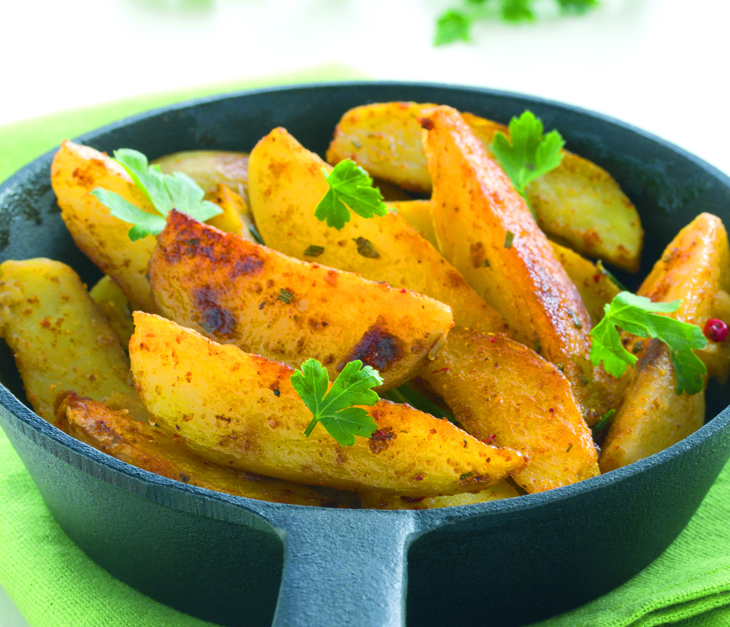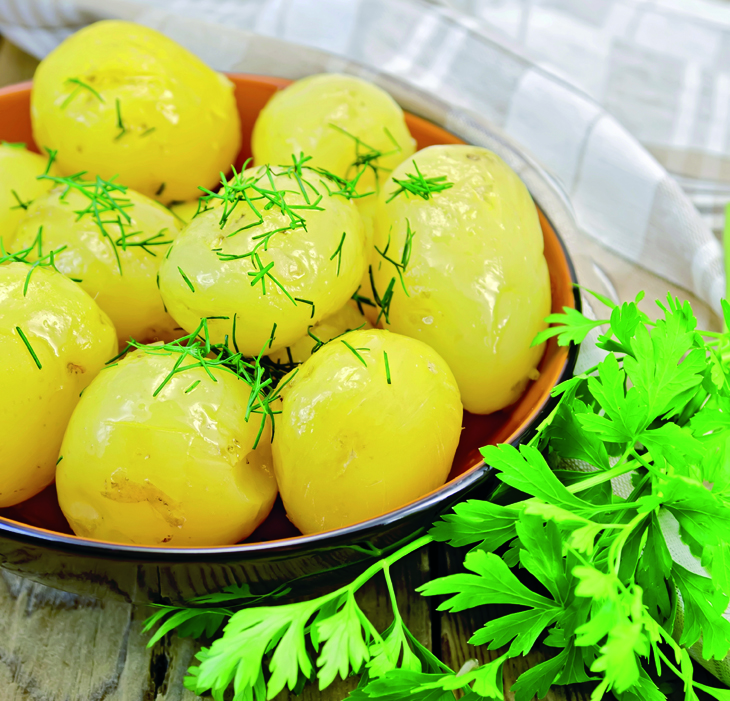FACTS AND MYTHS ABOUT POTATO
Why is it worth eating potatoes?
Potatoes act as a healthy, dietary product – just like other vegetables.
Potatoes are low in calories, they give you a feeling of fullness, but they do not cause obesity.
Consumption of a 200 g serving of potatoes covers 50% of the daily requirement (70 mg / person) for vitamin C and 40% for potassium.
Potatoes contain approx. 2% of protein with high biological value.
The alkaline mineral composition of potatoes (potassium, calcium, magnesium) neutralizes the acidifying effect of cereal products, meat and fish.
Potatoes are a new cheap change.
Protein, vitamins and mineral salts contained in potatoes support the proper development of children and adolescents.
The multitude of potato dishes – the basis of young people’s creativity.
For those more interested in potatoes …
We recommend an article on the use of edible potato varieties in the fight against obesity
How to eat potatoes without gaining weight?
It’s healthiest to eat potatoes without any sauces, preferably cold in salads, but without mayonnaise. In cooled potatoes, some of the starch turns into some kind of fiber that is not digested. This information is especially important for diabetics, who can eat potatoes in this form and hot puree is not recommended for them.
How to check which dish is a potato suitable for?
You can take a quick test! Rub the halves of a cut potato together …
If the flesh is clearly sticky – it is good for dumplings, dumplings or purée (this is culinary type C) If there is water – the potato is good for french fries and salads (type A or AB).
Tasty varieties that can be eaten without additives
Baked and boiled potatoes are the healthiest. For cooking, choose tubers of a similar size, scrub them well and toss them into salted boiling water. Cooked potatoes eaten cold (e.g. in salads) have fewer calories.
Culinary types A, B, C
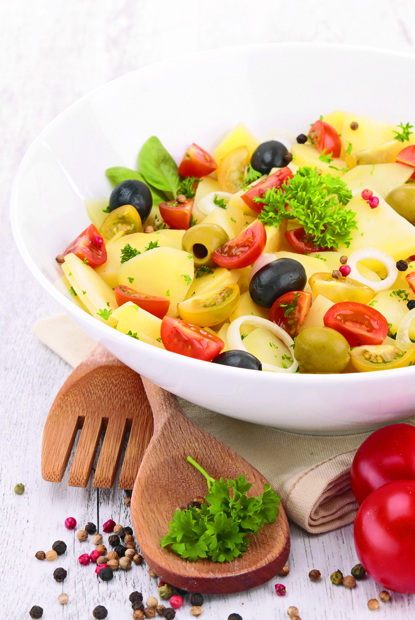
Culinary type A (salad):
- the flesh remains firm after cooking
- does not overcook and can be easily sliced and diced
- perfect for salads, casseroles, frying and soups
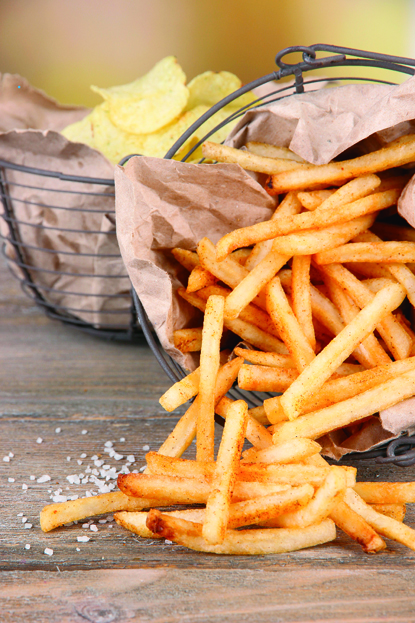
Culinary type B (general use):
- the flesh is quite firm after cooking, but it is slightly squashed under a fork
- universal type, such potatoes are most often eaten cooked for dinner, are suitable for soups, frying in slices, for chips, pancakes, potato dumplings, dumplings, dumplings, potato wedges, etc.
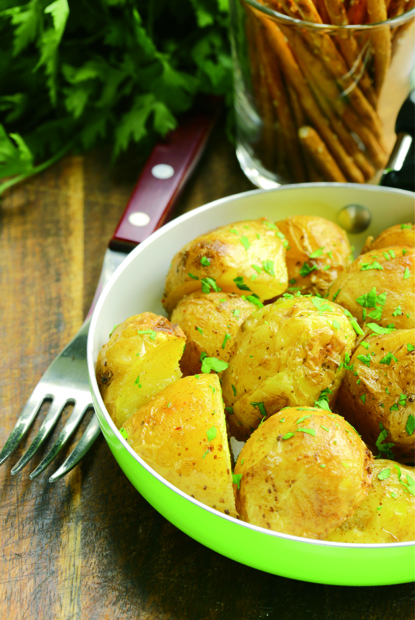
Culinary type C (floury):
- after cooking, the flesh is crumbly, has a soft consistency and is slightly dry
- suitable for puree, pies, fries, crisps, potato cakes and baking
Ask about these varieties in stores …
List of edible varieties from the National Register useful for more important directions of use (culinary types *)
| Direction of use and culinary type of varieties | List of useful varieties |
| For cooking in water and steaming (with and without peel) with good taste and nice appearance of tubers (mainly culinary type B) | Arielle, Asterix, Bellarosa, Berber, Bila, Bogatka, Bohun, Cyprian, Ditta, Eurostar, Folva, Fresco, Gwiazda, Ingrid, Irga, Irys, Jelly, Jurek, Krasa, Lavinia, Malaga, Michalina, Mondeo, Oman, Owacja, Promyk, Raja, Ramos, Rosalind, Satina, Stasia, Syrena, Tajfun , Tetyda |
| For making purée and baking in foil (intermediate culinary type BC) | Agnes, Amora, Ametyst, Augusta, Bursztyn, Bryza, Cekin, Courlan, Etola, Ewelina, Fianna, Finezja, Gawin, Gracja, Gustaw, Ibis, Jutrzenka, Laskara, Legenda, Justa, Mazur, Marlen, Miłek, Veronie |
| For making pies, dumplings and dumplings (culinary type B and B-BC) | Arielle, Asterix, Bila, Bogatka, Bohun, Bryza, Eurostar, Finezja, Folva, Fresco, Jelly, Malaga, Marlen, Mazur, Mondeo, Oman, Owacja, Rosalind, Satina, Syrena, Tajfun, Tetyda, Veronie, Vineta |
| For making salads, casseroles and soups (intermediate culinary type AB) |
Almera, Altesse, Annabelle, Carerra, Cecille, Dali, Denar, Hubal, Impala, Lord, Oberon, Orchestra, Otolia, Viviana, Vineta, Zenia |
| For baking (with large tubers) | Amora, Arielle, Asterix, Bartek, Bellarosa, Bila, Cekin, Cyprian, Eurostar, Folva, Fresco, Innovator, Jelly, Justa, Mazur, Miłek, Mondeo, Owacja, Raja, Ramos, Satina, Syrena, Tajfun, Tetyda, Veronie, Vineta |
| For cooking and serving whole (with small tubers) |
Annabelle, Aruba, Cecile, Ditta, Ingrid, Irga, Irys, Lavinia |
| For packing boiled tubers (with non-darkening cooked flesh – rating 8.5-9.0) | Almera, Altesse, Annabelle, Arielle, Asterix, Bila, Bogatka Bohun, Carrera, Denar, Fresco, Folva, Gwiazda, Impala, Ingrid, Jelly, Lord, Michalina, Orchestra, Owacja, Ramos, Satina, Stasia, Syrena, Tajfun, Tetyda, Veronie, Viviana, Vineta |
| For packing raw tubers (with non-darkening raw flesh – rating 8.5) | Asterix, Altesse, Bogatka, Cecile, Denar, Ewelina, Fianna, Gwiazda, Impala, Ingrid, Jelly, Malaga, Michalina, Oman, Orchestra, Satina, Tetyda, Viviana |
* Culinary types
- Type A – salad. The tubers are quite firm, do not overcook, can be cut, the structure of the flesh is delicate.
- Type B – general purpose. The flesh of the tubers is slightly mealy, slightly moist, delicate structure, firm or quite firm consistency.
- Type C – mealy. The pulp of the tubers is slightly floury, loose, rather dry, with a rather rough structure.
- Type D – very mealy. Tuber flesh is very dry, structure very rough, often fibrous. They overcook completely.
There are also intermediate types, e.g. AB, BC, B-BC, which combine both types.
Source: IHAR-PIB, ZNiOZ in Bonin, e-mail: irenastypa @ .wp.pl. based
the results of the COBORU and IHAR PIB ZNiOZ experiments in Bonin.
This may be of interest to you


